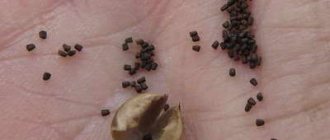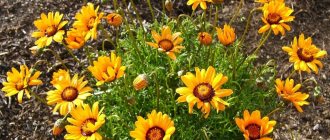- October 15, 2018
- Flowers
- Natalia Miroshnikova
Increasingly, attractive lumbago flowers are being grown in household plots. These beautiful primroses decorate the landscape when other plants have not even woken up. You will learn how to grow and care for lumbago from our material.
Description
The lumbago flower, which is also called snowdrop, dream grass, anemone and pulsatilla, is a prominent representative of the Ranunculaceae family. In its natural environment, this perennial herbaceous plant can be found on rocky slopes, forest edges and meadows of Siberia, the Caucasus and the European part of Russia. There are 40 types of culture, and 25 of them are listed in the Red Book.
For growing in gardens and flower beds, common lumbago is more often used. This shrub reaches 30 cm in height and 20 cm in diameter. It has finely dissected, feathery leaves, colored in bright green tones. At first they are very pubescent, but then they become smooth.
The plant blooms in mid-April - early May. At this time, pubescent, bell-shaped buds appear on its stems. Their diameter reaches 4–9 cm. The petals are colored violet, purple and occasionally white. But thanks to the efforts of breeders, varieties with red, yellow and even black buds have been developed.
Lumbago growing from seeds at home
Sleep grass is a fairly fast-growing spring flower. There are about 40 varieties of this plant. It lives mainly in subtropical and temperate climates.
The plant blooms in the second half of April and begins in early May. Their bell-shaped inflorescences are soft purple. After the inflorescence, leaves begin to appear, and with their thick fibers they give a special appearance to the flower.
The villi on the flower save it from loss of moisture during drought and protect it from hypothermia. Therefore, it is resistant to spring weather changes. For its extraordinary beauty and unpretentiousness, many people plant dream grass in their area. Sowing is done only with seeds.
Common lumbago is a perennial, frost-resistant, and tolerates drought well. It reaches a height of up to 30 centimeters, and on one bush there are up to 50 inflorescences at the same time.
to contents
The best varieties of common lumbago
Breeders have developed many varieties of this primrose. But the following varieties have gained particular popularity among gardeners:
- Rote Glocke. The buds of this variety are shaped like tulips. At the beginning of flowering they are painted a rich red color, but then they turn pale and turn pinkish.
- Papageno. The variety is distinguished by its large bud sizes. Their diameter reaches 7–8 cm. The snow-white petals of the plant are dissected at the tips, which gives the flowers additional volume.
- Papageno Black. This variety is valued by gardeners for its large buds with a diameter of up to 8 cm. The petals of the bells are painted in rich purple tones.
- Mrs van der Elst. The variety is distinguished by the soft pink color of its bells. They reach up to 9 cm in diameter.
- White Swan. Translated, the name of the variety means “white swan”. And this name suits the variety, because the buds of the crop are painted snow-white.
- Pinwheel Dark Red Shadows. The plant grows up to 30 cm in height. It has large bells, colored in reddish-violet tones. The variety is frost-resistant and suitable for growing in regions with harsh climates.
Each of these varieties will decorate your site. In addition, lumbago flowers cross-pollinate among themselves. And if you plant several varieties nearby, then in 3-4 years you will get interesting hybrids with an unusual shape and bright color of the petals.
Common and spring flower: planting and care
Lumbago, or as they are popularly called, sleep-grass, from the buttercup family, grows in Siberia, Europe, and the Caucasus. There are 45 species in the genus. They grow straight and are covered with hairs. Over time, when the flower gets older, it increases the number of leaves, and in adulthood there are already about 200. The plant is about 50 cm in length. The flowers are large, shaped like bells, about 8 cm in diameter. The color is white with golden or silver tint, golden yellow, violet, purple. As soon as the flower begins to fade, its peduncle lengthens, forming a multi-nut fruit.
Growing lumbago seeds
The lumbago flower, a photo of which is given in the material, reproduces only by seed. Moreover, it is better to germinate the plant using the seedling method, although direct planting in open ground is allowed. But the germination of grains noticeably deteriorates. In addition, sowing in open ground is carried out in the fall, and not all plants survive until spring.
Start sowing in early to mid-March. For seedlings, use seeds of lumbago flowers, collected in the fall or purchased in a special store. But keep in mind that the fresher the grains, the higher their germination rate.
Growing lumbago in a flower bed
With the onset of steady warmth, spring flowers appear in the forest, among which lumbago looks very unusual (pulsatilla, sleep grass). However, growing lumbago in garden plots is quite possible if certain rules are followed. This plant pleases with large bright flowers, there are several types (the result of selection) and shades.
Due to its high popularity, unscrupulous sellers often dig up sleep grass bushes in the forest and sell them. However, such plants do not take root, since their long taproot is damaged when dug up.
Growing lumbago seedlings
Since lumbago does not tolerate transplantation, this plant can only be grown by seed. About 20 species of pulsatilla are grown in our latitudes. In order to obtain seedlings, lumbago seed stratification is necessary. In nature, scattered seeds are located on the surface of the soil; they go through several stages of drying and moistening. The moistened seed is “embedded” into the soil by its awn. Approximately the same conditions must be created when planting seedlings.
Sowing of seeds is carried out in early spring, in the first half of March. Some people practice autumn sowing of lumbago, but in this case the germination rate will be low.
How to plant lumbago seeds
To obtain good seedlings, it is necessary to take into account a number of factors:
- freshness of seeds;
- the soil;
- germination conditions.
Sowing
If you sow fresh seeds, you do not need to prepare them before sowing. Soak grains that are a year old or older for 2-3 hours in a solution of Epin or acid. This will increase their germination rate. Place the seeds on the surface of the moistened soil and lightly sprinkle them with sand. A layer 0.5-1 cm thick is enough.
After sowing, cover the container with plastic or glass. Place the planting in a warm, bright place. In order for the seeds of the lumbago flower to germinate, it is important to maintain the temperature in the greenhouse at +22…+25 °C. Ventilate the planting regularly and periodically spray the soil with warm water from a spray bottle, preventing the substrate from drying out.
How to plant lumbago seeds
Before you start growing lumbago seedlings from seeds, you should prepare. It is advisable to stratify them in advance, and to stock up on convenient containers and a suitable soil mixture by the scheduled planting date.
Selection of containers and soil preparation
It is most convenient to use a wide, shallow container (wooden box, plastic container) for sowing lumbago seeds for seedlings. A prerequisite is the presence of a sufficient number of holes in the bottom of the container to drain excess moisture.
It is most convenient to sow lumbago seeds in a wide, shallow container with holes in the bottom for drainage.
The soil for lumbago seeds should be light and loose. You can mix leaf soil or purchased substrate and fine river sand in equal proportions. A day before the intended sowing, the soil needs to be well moistened.
Advice! You should additionally prepare a little sand; it will be needed during the planting process in order to lightly sprinkle the seeds.
Preparation and stratification of lumbago seeds
Stratification of seed material imitates the effect on it of a certain temperature and humidity under natural conditions. This process stimulates the awakening of seeds and their transition from the dormant phase to the growth phase.
1-2 months before sowing, a container with seeds mixed with wet sand should be placed in the vegetable compartment of the refrigerator for stratification
To germinate sleep grass, so-called “cold” stratification is performed. 1 volume part of the seed is mixed with 3 parts of wet sand, peat or sawdust, placed in a plastic bag and placed in the vegetable compartment of the refrigerator for 1-2 months.
Immediately before sowing, it is recommended to soak the seeds for a couple of hours in a stimulant solution (Epin, succinic acid). This will enhance their ability to germinate.
Advice! If it is not possible to keep sleep grass seeds in a stimulator, you should immerse them in clean water at room temperature a day before sowing.
How to sow the seeds of lumbago
The correct way to plant lumbago seeds is as follows:
- The prepared seed material is evenly distributed over the soil surface. The most convenient way is to carefully place them at a distance of a couple of centimeters from each other, using tweezers.
- The crops are lightly pressed into the soil, but not buried. It is permissible to lightly sprinkle them with fine sand on top.
- Spray the lumbago seeds with warm, settled water from a spray bottle.
- Cover the container with glass or plastic film, forming a “greenhouse”, and place it in a bright, warm place.
Seedling care
Under comfortable conditions, the first seedlings of lumbago flowers appear three weeks after sowing. If this does not happen, then stop watering the soil for 14 days, and after this time, resume irrigation. This way you will imitate natural conditions for the crop, which will improve the germination of grains.
When the seedlings have 2-3 leaves, drop them into a separate bowl. For young lumbago flowers, choose deep glasses or pots with a volume of 0.5 liters. Use soil with the same composition as for sowing seeds.
It is advisable to plant lumbago flowers grown from seeds the following year. But you can plant seedlings at the end of summer. Then be sure to cover the young plants with spruce branches before the cold weather, otherwise they will not survive until spring.
How to grow lumbago from seeds at home in winter
It is not difficult to grow lumbago from seeds if
- purchase freshly harvested seeds and,
It is safer to grow lumbago from seeds yourself than to buy ready-made seedlings. Since it often does not take root due to the tap root of the plant. A lumbago grown from seeds will bloom only in the third year. But in the future, an increasing number of flowers will be collected every year.
Young seedlings of lumbago at the age of six months or a year are available for sale. Such seedlings take root more easily than older ones.
Choosing a place for flowers
This plant does not tolerate transplantation well and feels great in one place for up to 20 years. Therefore, carefully select a site for the crop and take into account its characteristics. Lumbago is a light-loving flower, but too open areas are not suitable for it. Therefore, choose places in partial shade. It is advisable to plant the flower bed on a hill. Since rain and melt water accumulates in the lowlands, and from excess moisture the plant rots and dies.
Acceleration of germination and picking of lumbago seedlings
Fresh seeds germinate in 2 weeks, but sometimes germination can take up to 6 weeks. To help the seedlings gain a foothold in the soil, make a small hole next to the sprouted seed with a toothpick, point the root into it and carefully sprinkle it.
To help the seedlings get rid of the seed coat, moisten them with a spray bottle and remove the shells with tweezers. If after 3–4 weeks the seeds do not show signs of life, alternately repeatedly drying and moistening them or cooling them in the refrigerator for 2–3 weeks will help. Some species (mountain and alpine) do not germinate at all without stratification.
With the appearance of the first true leaf, the seedlings are planted in separate pots without deepening the root collar.
The younger the plant, the better it takes root. The hole must be deep so that the root fits into it without bending (5).
The composition of the soil mixture is the same as for sowing. Lightly compact the soil around the seedling and water it carefully.
Planting in open ground
The plant prefers light, fertile loams or sandy loams with an alkaline or neutral reaction. A week before planting the lumbago, dig up the area with a spade and add some sand, peat and mineral fertilizers to the ground. It is also useful to treat the soil with fungicides. This will protect the plants from fungal diseases.
Plant seedlings in holes with a depth of 20–30 cm. Keep a distance of 40–50 cm between plants. If the groundwater in the area lies close to the surface, then be sure to place a drainage layer at the bottom of the recesses.
Moisten the seedlings generously and remove them from the containers without damaging the earthen ball. Plant young plants in the prepared recesses and fill the voids with soil, lightly compact the surface. Make sure that the root collar is level with the ground.
Growing rules
There are certain rules for growing aster seedlings from seeds at home - if you follow these tips from agronomists, you can get high-quality planting material for your garden plot.
Points to pay attention to:
- temperature – during germination it should be elevated (about 25° C), and after emergence moderate (18 – 20° C), if the seedlings begin to stretch, then lower the temperature to +16° C;
- You cannot keep the seedlings constantly under a film - this provokes the development of rot;
- do not allow the seedlings to thicken - a black leg may develop;
- The lighting period per day should be 12 hours; if the day is shorter, then use phytolamps;
- It is worth watering the aster seedlings as the soil dries out, but do not allow it to dry out, use only boiled warm water;
- Fertilize with mineral preparations 2 weeks after picking at intervals of 1 time every 7 days (avoid using complexes with a high percentage of nitrogen).
If signs of root collar rot (blackleg) appear, all dead seedlings should be removed. Then spill the soil with Fitosporin-M solution. Sprinkle a 3-4 mm layer of sifted wood ash on top.
Sowing flowers directly in open ground
This growing method is justified if you do not want to waste time on seedlings and you have a lot of lumbago seeds, because not all of them will germinate. Start the event at the end of June - beginning of July. If you have high-mountain varieties of lumbago, then sow them in the fall.
Prepare the site in the same way as when growing by seedling method (see “Planting in open ground”). Plant the seeds in a thick layer to a depth of 1.5 cm. To prevent future plants from overheating or getting too cold, cover the planting with straw. The first seedlings will hatch in 20–30 days. In the future, provide them with normal care.
Compositions in the garden
The lumbago blooms earlier, it looks good with various shrubs and trees, and looks elegant in the garden. It can also be combined with spring flowers, for example, with spring Adonis, crocuses, and primroses. They are planted along the paths. You can simply take several varieties of this plant or try to grow a whole group. You should not dig up plants and move them from their natural habitat, since they will not survive transplantation anyway.
Planting and growing a plant
The lumbago is planted in a flowerbed where perennials are adjacent; an alpine slide and rockery are also suitable. The plant cannot tolerate dampness! You need to choose a place for shooting with light shading, however, in sunny places, the culture also feels good. Place the flower on the south side of the garden. It would be great if the chosen location has a slope that will not allow water to stagnate. Since the seeds are sensitive to light, it is better to cover them with a layer of soil, but not too much. Plant care:
- The lumbago needs to be fed. Fertilizers containing lime and nitrogen are suitable for this. Potassium-phosphorus supplements are also necessary, but they are applied only twice a season. There is also a chance in poor soil that lumbago can grow from seeds without fertilizer.
- The soil for sowing lumbago seeds must be treated with fertilizers, which are applied in the fall. In the spring, before planting seeds, it is necessary to loosen the soil.
- Care should include weeding, watering as needed, and mulching with peat and humus. This plant is frost-resistant, so it should survive the winter period without loss.
Reproduction
The plant does not lend itself well to transplantation, so it is propagated by seeds . Flowering of urchin planted in this way begins already in the second year of life. However, remember that high-altitude varieties can delay flowering time by years. Therefore, buy seeds of common lumbago and there will be no problems with flowering.
Read also: Tamarix planting and care in open ground in the Urals
For planting, take fresh seeds; their germination rate is much higher than old ones. Plant in June or July. It can be produced in the spring, but in this case the earth must be warmed up. The lumbago will be comfortable at a temperature of 21 to 25 degrees.
Some varieties are sown in autumn because they require stratification. Crops will appear in May. In the spring, try sowing lumbago in containers on the windowsill , and in the summer transplant the seedlings into open ground. However, remember that the plant does not tolerate transplantation well. If you plant several varieties together, you can get interesting plant forms that will be far from the parent.
There are a large number of types and varieties of lumbago. It is picky about soil and light, but still adapts well to dacha conditions.
Watering
Lumbago is a drought-resistant plant. Primrose tolerates waterlogging much worse than lack of moisture. But the soil should not be allowed to dry out completely. Therefore, occasionally moisten the plants during the dry season.
Young seedlings need more moisture, because it helps the flowers take root well. Water plants frequently during the first two years after planting. But don’t get carried away to prevent moisture stagnation at the roots. Irrigate strictly at the root. It is advisable to use melt or rain water, or pre-settle tap water.
The use of lumbago in landscape compositions
The use of lumbago in landscape design is widespread among modern florists and gardeners. Thanks to its attractive color, lumbago looks advantageous in any floral composition.
The plant blooms in spring or early summer with single, bell-shaped, pubescent flowers of violet, purple, golden yellow, red, burgundy or white. All the colors of this plant look very impressive in gardens (including rocky ones), on open lawns, alpine hills, in group plantings along the edges of pine and deciduous forest park areas. The lumbago also looks elegant in combination with other plants, such as crocuses, primrose, scylla, and tulips.
Did you know?
The “sleep-grass” known in folk legends is the blackened lumbago. The species is on the verge of extinction, as it is constantly being dug up by unscrupulous flower traders. This name for lumbago has ancient roots. Its ability to induce sleep was noticed by healers and herbalists many years ago. They believe that being shot makes bears drunk, and if a hunter falls asleep on these flowers, he will sleep until the end of spring. Also, lumbago flowers have long been assigned magical powers; they were used in fortune telling and to scare away evil spirits.
Loosening and mulching
The next day after watering or rainfall, be sure to loosen the soil near the flowers. Otherwise, a crust will form, blocking air access to the roots. And this has a bad effect on the decorativeness of lumbago flowers. Carefully loosen the soil to a depth of 5–10 cm.
When loosening, do not forget to remove weeds. Carry out the activity manually so as not to damage the shoots of the crop with garden tools.
To prevent rapid evaporation of moisture, mulch the surface of the flower bed with sawdust or humus. This layer will reduce plant care, because you will have to water and loosen the soil less often. In addition, mulch will prevent the growth of weeds and nourish the seedlings with useful substances.
LiveInternetLiveInternet
—Categories
- ***MY. (115)
- My knitting (45)
- My sewing (9)
- My cat (Peach) (8)
- LiveInternet (121)
- LiRu-educational program (22)
- Mastering the computer (19)
- Diary design (16)
- Types of knitting (859)
- "Pineapple" (19)
- "Lily" (35)
- "Leaves" (46)
- "Bear Paws" (23)
- Jacquard (13)
- Illusion knitting (6)
- Yoke, raglan (118)
- Braids, arans, plaits (116)
- Ribbon lace (45)
- Missoni(crochet) (67)
- Missoni(knitted) (14)
- Sirloin knitting (169)
- Sirloin knitting 2 (103)
- Types of knitting - “Ireland” (429)
- Videos, MK, tips, lessons (133)
- Models for inspiration (63)
- Models with descriptions (142)
- Motifs+schemes (91)
- Types of knitting - “Motifs” (321)
- "African Flower" (16)
- "Granny Square" (38)
- Ideas (28)
- Models with descriptions (187)
- Motives+schemes (49)
- Knitting (2024)
- Craftswomen with LiRu (29)
- Evening dresses (77)
- Knitting for men (131)
- Knitting+fabric (65)
- Hats (130)
- Designer models (67)
- Lace, border, collars (78)
- Shoes, socks, mittens (61)
- Blankets, pillows, rugs (172)
- Napkins-tablecloths-curtains (166)
- Bags (143)
- Jewelry, flowers (114)
- Scarves-shawls-stoles (235)
- Japanese openwork (445)
- Knitting. Everything for children (680)
- . undisassembled. (69)
- for girls (189)
- for children under 1 year (59)
- for boys (133)
- magazines, websites (22)
- toys, etc. (5)
- ideas (10)
- shoes, etc. (63)
- blankets, etc. (54)
- hats, etc. (93)
- Knitting.Women's clothing (crochet) (270)
- Sleeveless vest, vest, etc. (12)
- Blouses, pullovers, etc. (92)
- Coats, cardigans, jackets (85)
- Dresses, suits, tunics (81)
- Knitting.Women's clothing (knitting needles) (808)
- Vest, bolero, sleeveless vest (59)
- Blouse, pullover, sweater (436)
- Coats, cardigans, jackets (178)
- Dresses, suits, tunics (133)
- Knitting. Summer is coming! (989)
- Boleros, jackets (140)
- Set (8)
- Blouses, tops (251)
- Men (7)
- dresses, sundresses (230)
- beachwear (40)
- tunics (141)
- Hats, umbrellas (31)
- skirts (113)
- Knitting.Knitting tips (446)
- types of yarn (17)
- hook (72)
- master classes (well, a lot. ) (35)
- knitting needles (167)
- crochet patterns (72)
- knitting patterns (77)
- For the soul. (194)
- A. Celentano. ))) (15)
- V. Obodzinsky. (2)
- Vera (18)
- All for the party! (20)
- Birthdays-weddings-anniversaries (16)
- Let's relax! (2)
- Parables, stories, poems (41)
- Everyone watch. (13)
- This is interesting! (18)
- House-garden-vegetable garden (926)
- *** (2)
- all about indoor plants (77)
- we protect and fertilize. (140)
- interior (7)
- landscape design (56)
- vegetables:eggplant (8)
- vegetables: cucumbers (66)
- vegetables: pepper (8)
- vegetables:various (24)
- vegetables: tomatoes (53)
- vegetables:garlic (10)
- vegetable garden on the windowsill (20)
- useful tips (80)
- natural farming (66)
- vegetable seedlings (25)
- flower seedlings (9)
- garden flowers (49)
- fruits: apricot, peach (6)
- fruits: quince, etc. (3)
- fruits: cherry plum, plum (3)
- fruit:cherry (12)
- fruits:apple, pear (22)
- conifers, shrubs (12)
- bulbous flowers (1)
- perennial flowers (25)
- annual flowers (23)
- flowers - petunias, calibrachoa (17)
- rose flowers (34)
- eustoma flowers (1)
- berry:grape (26)
- berry: honeysuckle, etc. (7)
- berry:strawberry-strawberry (52)
- berry: raspberry, blackberry (30)
- berry: currant, gooseberry (7)
- Magazines and books on needlework (264)
- Asian magazines-1 (48)
- Asian magazines-2 (37)
- Knitting is your hobby (2)
- Fashion Magazine(1) (50)
- Fashion Magazine(2) (13)
- Handicraft books (8)
- Miscellaneous. (28)
- Health (756)
- . Let's exercise! (99)
- Children's health (8)
- Time-tested medicines (43)
- medicinal plants (48)
- we are being treated. (106)
- we bring beauty. ))) (181)
- healthy products (128)
- useful tips (85)
- We're losing weight. (31)
- Cooking (1343)
- Albums and magazines on cooking (4)
- Pancakes, donuts, bread, etc. (23)
- Oriental sweets (5)
- hot dish (90)
- cook from cereals (4)
- dessert, cookies (168)
- preparations for the winter (jam, etc.) (10)
- preparations for the winter (marinades, etc.) (67)
- preparations for the winter (salads, etc.) (81)
- preparations for the winter (sauces, etc.) (49)
- Korean cuisine (20)
- cooking tips (33)
- Easter cakes, cupcakes, etc. (30)
- Chicken dish (27)
- Meat dish (13)
- hastily. (114)
- drinks (12)
- Dumplings, manti, dumplings, etc. (10)
- Pies, pies (99)
- Pizza, Ossetian pies, placinda, etc. (31)
- Festive table (74)
- Recipes from Stalik Khankishiev (4)
- Fish dish (7)
- salads (105)
- Samsa, pasties, khachapuri, etc. (61)
- Sauces, seasonings, cheeses (28)
- Cake, pastry (133)
- cold appetizers (meat) (61)
- cold snacks (vegetables) (37)
- cold appetizers (fish) (62)
- Crazy hands ))) (3)
- Useful sites (13)
- Useful tips (127)
- Online stores (4)
- clean house (88)
- Thrifty housewife (15)
- Child development (5)
- Handicrafts (44)
- Beading (2)
- Guilloche (1)
- Handmade (188)
- decoupage (3)
- toys (33)
- gift ideas (39)
- kanzashi (13)
- quilling (6)
- newspaper weaving (16)
- various techniques (11)
- topiary (3)
- flowers made of fabric, leather, ribbons (33)
- Film library (22)
- Cinema (6)
- Cartoons (12)
- Television (4)
- Sewing is beautiful and easy! (351)
- Boho style (103)
- Evening dresses (9)
- Patterns, modeling and MK (136)
- Children (26)
- For home (15)
- The art of dressing well (29)
- Essential tips (12)
- Rework (18)
- Bags (24)
- Curtains (102)
- Video MK (7)
- Patterns, patterns (21)
- Curtain decor (10)
- The beauty of windows (17)
- Master classes (43)
- Sites, links (6)
Read also: Remontant yellow raspberry planting and care in open ground
—Applications
- Postcards
Reborn catalog of postcards for all occasions - I am a photographer
Plugin for publishing photos in the user's diary. Minimum system requirements: Internet Explorer 6, Fire Fox 1.5, Opera 9.5, Safari 3.1.1 with JavaScript enabled. Maybe it will work - Cheap flights
Favorable prices, easy search, no commission, 24 hours. Book now - pay later! - Rating buttons "Yandex.blogs"
Adds Yandex rating buttons to the profile. Plus, graphs of rating changes per month will appear soon - Online game "Empire"
Transform your small castle into a mighty fortress and become the ruler of the greatest kingdom in the game Goodgame Empire. Build your own empire, expand it and defend it from other players. B
-Video
-Always at hand
—Quote book
NATURAL PASTE-BALM FOR HEALTHY TEETH AND GUM WITH YOUR OWN HANDS! The paste is intended for...
LACERY TOP AND TUNIC - RAGLAN FROM THE NECK. HOOK
LILAC FILE JUMPER WITH ROSE
This poem heals the body and soul! There is so much anger, envy, resentment and pain in our world...
raglan jumper from Austin (online in the Country of Mothers) Published by tetyana1506 in the group Knitting together.
—Search by diary
—Subscription by e-mail
Diseases and pests
Lumbago is a flower with strong immunity. But occasionally he gets sick with blackleg. This disease is quite difficult to treat, so it is better to prevent it. To do this, first treat the soil where you will plant primroses with fungicides.
In winter, primroses can be chewed out by rodents. To prevent this from happening, use “Tornado”, “Amus” or “Testox” poisons to protect the plant. But when working with drugs, be extremely careful and strictly follow the instructions for use.
Of the insect pests, only slugs and snails annoy sleep grass. To combat these parasites, use the Thunderstorm or Slug Eater insecticides. Eggshells also help protect the flower from pests. It needs to be crushed and scattered over the surface of the flower garden.
Growing an attractive primrose in your garden is not that difficult. The main thing is to provide proper care for the lumbago flower and create comfortable conditions for it. He will definitely thank you with attractive delicate buds that will delight the eye every spring.
General information about the plant lumbago
For most peoples of the world, sleep is associated with sleep. This may be due to the appearance of the plant itself. Sleep grass is covered with delicate, soft hairs that bring to mind thoughts of sleep, relaxation and rest. There are legends that as soon as you put grass under your head, you will immediately fall asleep.
Dream grass, when it blooms, is covered with pleasant-to-the-touch fibers. And the inflorescences of the lumbago look like bells.
Previously, hunters, watching bears, came to the conclusion that lumbago has the ability to intoxicate and make you sleepy. The root especially has this property, which is why the second name sleep grass appeared.











